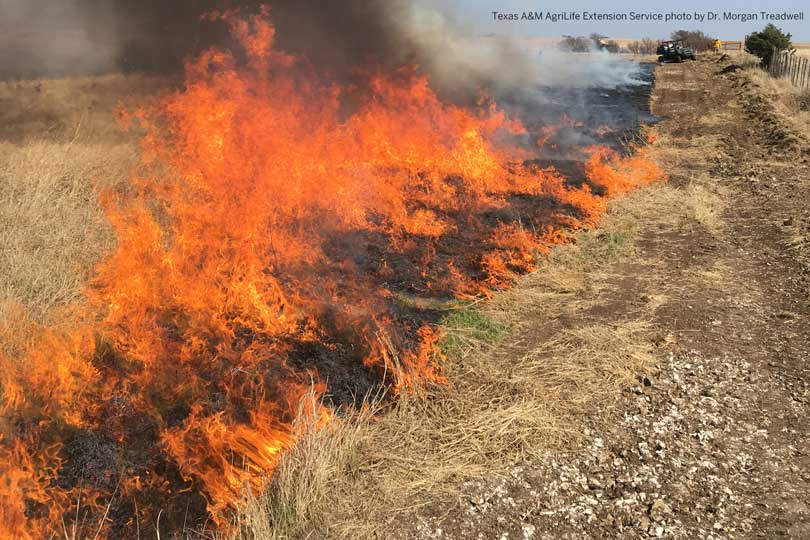By Jennifer Dorsett
Field Editor
Prescribed burning is one way to fight wildfires with…well, fire.
While controlled burning can rid forested areas of excess leaves and other highly flammable material, it’s also a way to improve rangeland, restore prairies and manage wildlife habitat.
More Texans are taking note of the management practice. A recent Texas A&M Forest Service survey showed more than 400,000 acres were treated by prescribed burns in 2018, an increase of nearly 50,000 acres over the previous year.
“Folks are starting to understand that prescribed fire is not just a wildlife tool or a livestock tool, but it’s also a fuel-reduction tool,” Dr. Morgan Treadwell, Texas A&M AgriLife Extension Service range specialist, said. “We’re seeing agencies increase their acres burned. We’re seeing our commercial and certified burn managers increase their acres burned. Our Prescribed Burn Association in the Panhandle burned over 20,000 acres in 2018, and that’s just really incredible.”
In nature, wildfire isn’t always harmful, Treadwell noted.
“Throughout Texas and the Great Plains—particularly the Southern Great Plains—we live in fire-dominated ecosystems where plants have evolved with frequent fire, and they actually need it to grow and thrive,” she said. “They need that type of disturbance and those processes to occur in order to be good habitat and support native species.”
Prescribed fires achieve specific land management objectives, such as restoring ecosystem health or recycling nutrients.
According to Treadwell, fire is one of the best management tools for invasive plant control, and prescribed burns help manage weeds and lower the risk of wildfires by reducing the amount of flammable fuel in the area. It can also restore nutrients to the soil and encourage healthy plant growth.
The State of Texas Natural Resources Code guarantees every landowner has the right to use prescribed burning to manage private property, unless there is a county burn ban in effect, Treadwell said.
However, in addition to respecting county burn bans, landowners may need to follow additional county regulations, such as obtaining a burn permit or submitting a burn plan to officials.
But proactive burning is more than just lighting a match, tossing it in a field and waiting for the fire to burn out.
Although state law allows for landowners to conduct prescribed burns, Treadwell recommends using a certified and insured prescribed burn manager.
The Texas Prescribed Burning Board consists of representatives from several relevant state agencies and private landowners elected by Texas’ agricultural commissioner. The board sets prescribed burn standards and training curriculum for the prescribed burn manager certification program, which is overseen by the Texas Department of Agriculture (TDA).
“The state of Texas understands prescribed burning provides many benefits for the management of our rangelands, but there still are rules and regulations we need to follow that meet our standards of care and create a positive fire culture,” she said. “When someone is lighting a prescribed fire, they come to the table with experience. They come to the table with a crew, with a plan, and they are prepared to execute that prescribed burn efficiently and effectively.”
AgriLife Extension has created an online prescribed burn school to educate interested parties.
“Our online burn school is a really cool idea that has been in the works for several years,” Treadwell said. “This course walks you through all of the steps of a prescribed burn and gets you ready to participate in a prescribed burn field day. The cost is $200, and you can enroll at any time and set your own pace for learning.”
Once the course is complete, individuals have one calendar year from that day to participate in a field day and schedule the required certification exam.
“This is an effort to help the rancher or landowner who can’t afford to be away from away from animals or the farm for a week at a time just to participate in a burn school,” Treadwell said. “Overall education is increasing. Opportunities to burn and learn are also increasing, and we’re becoming much more open and transparent in this general fire discussion and conversation. It’s not just wildfire, and it’s not just prescribed fire, but it’s learning to live with fire and how to manage fire on these open landscapes.”
For more information on prescribed burning, including a free handbook download and information on the new online course, visit http://agrilife.org/rxburn.

